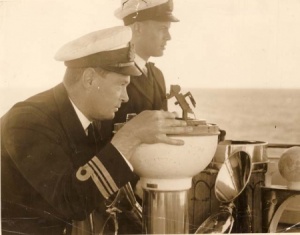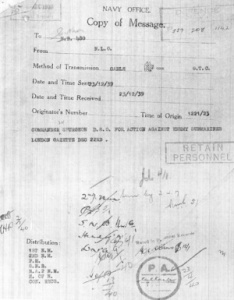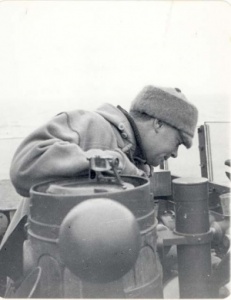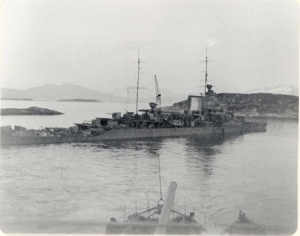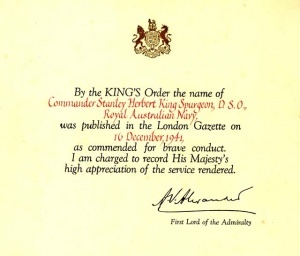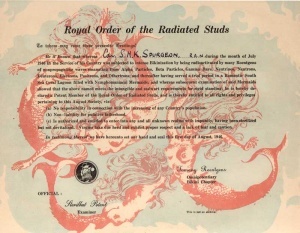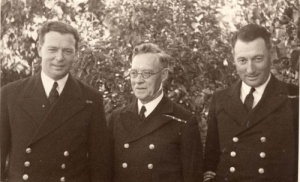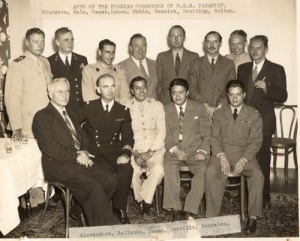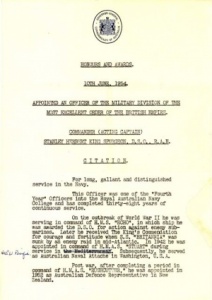Captain Stanley Herbert King Spurgeon
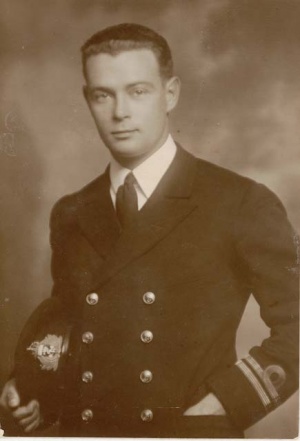
Captain Stanley Herbert King Spurgeon, RAN, (1902-1982). Born at Gosport in the United Kingdom on 15 May 1902, Stanley 'Spuddie' Spurgeon was the second son of Charles H Spurgeon and his wife Harriet. Leaving the Royal Navy as a Chief Writer, Charles Spurgeon had accepted an appointment to the then Commonwealth Naval Forces in 1912 and, having received a wartime commission in the Royal Australian Navy (RAN), eventually retired as a Commander (S). Charles' first son, Arthur, was the first to follow in his father's footsteps, entering the Royal Australian Naval College in 1914; Stanley joined his elder brother two years later. The younger Spurgeon passed out from the College as a Midshipman in 1920 with maximum time gained and prizes for engineering (theoretical), physics and chemistry. His first ship was the cruiser HMAS Brisbane (I) from which he transferred to the battle cruiser HMS Renown, travelling in her to the United Kingdom with the Prince of Wales, who had just completed a tour of the Dominions.
Having gained experience in a variety of Royal Navy vessels, Spurgeon returned to Australia in 1924. He spent just two years at home before his selection as only the third RAN candidate to undertake the long anti-submarine (A/S) course at HMS Osprey at Portland. He graduated with top marks and then remained in the United Kingdom on instructional duties. Subsequent appointments included two periods as the Australian Squadron's A/S officer, executive officer of the flotilla leader HMAS Stuart (I) and command of the destroyers HMA Ships Voyager (I) and Waterhen (I). He was promoted Commander in 1937.
Spurgeon remained one of the very few A/S specialists in the RAN, and in mid-1938 he sailed again for the United Kingdom to undertake the Boom Defence Course. At the outbreak of World War II he was in command of HMS Echo a destroyer of the Fifth Flotilla operating in the Western Approaches. On 19 November Echo came to the aid of the British steamship Pensilva which had been torpedoed by the German submarine U-49 off the Bay of Biscay. The destroyer made an apparently successful counterattack against the U-boat and then returned to pick up all of Pensilva's survivors. U49 had in fact escaped, but the Distinguished Service Order that Spurgeon received for the action became the first Australian decoration of the war. Echo subsequently took part in the occupation of Iceland, and the North Sea Mine Barrage.
In April 1940 Spurgeon found himself Escort Commander for NP1, the first British troop convoy to Norway. Echo then remained based at Harstadt conducting patrols and troop transportation missions for the remainder of the unsuccessful Norwegian campaign. During one incident on 17 May, Echo rescued some 1000 embarked troops of the South Wales Borders and 600 members of the ship's company from HMS Effingham, an accompanying cruiser which had struck a submerged rock in a narrow Fjord. The dangerous manoeuvre of coming alongside Effingham had to be completed twice to get everyone off, but superb seamanship ensured that the operation was accomplished without casualties. Spurgeon then destroyed the already badly damaged cruiser with two well-placed torpedoes. The following month Echo became the last destroyer to evacuate British troops from Narvik after its capture by the Germans. With five other destroyers under his command Spurgeon worked continuously to transfer 24,000 troops from the wharf to the transports that had assembled off the port. Later in 1940, Echo was present during the abortive attack on the Vichy French Fleet at Dakar, and while based in Gibraltar took part in Western Mediterranean operations.
In March 1941 Spurgeon was on passage to Cape Town in SS Brittania when his ship was sunk by the German merchant raider Thor in the mid-Atlantic. The raider made no attempt to help the survivors and more than half of those onboard the merchant vessel eventually perished in the action and aftermath. While abandoning ship, Spurgeon came across a naval nurse visibly distressed and fearful that she could not manage the descent into the already crowded life raft below. He immediately lifted her down the 30-foot rope ladder, injuring his foot and rupturing a tendon in his shoulder. With 67 others Spurgeon found himself in a 25-foot open lifeboat which was holed in several places and had onboard negligible food and water. As the senior officer Spurgeon established a system of rationing and a suitable routine to maintain morale. After six days adrift the boat was picked up by a Spanish steamer and taken to the Canary Islands where Spurgeon was interned for four months. He later received a commendation for his courage and fortitude in the trying circumstances he had faced.
Having finally returned to Australia, Spurgeon took command of Stuart (I) early in 1942 and was thereafter employed on escort duty off eastern Australia and in New Guinea waters. He took part in operations against the Japanese on Normanby and Goodenough Islands in September-October 1942. In May 1943 he became the first Director of the Anti-Submarine Division and by the end of June had established the unit in Melbourne with a small joint and combined staff. Collocated with, but independent of Navy Office, Spurgeon became the highest authority for anti-submarine matters in the South West Pacific Area, responsible for the practical and technical planning of anti-submarine measures and controlling the dissemination of information from all sources.
At the end of 1944 he was appointed Naval Attache at Washington, becoming a member of the Australian delegation to the San Francisco conference to establish the United Nations (UN) in April 1945. The following year he was the sole Australian representative at the American atomic bomb experiments at Bikini Atoll (Operation CROSSROADS). One of 21 UN representatives invited to the tests by the US State Department, Spurgeon was embarked in USS Panamint, an amphibious flagship, stationed some 21 miles away from the target array during the first test and at about half that distance during the second. Once levels of radioactivity were declared safe, Spurgeon was able to make a first hand inspection of the damage caused among the target vessels. His report back to Australia makes interesting reading, for it was a time when many analysts were questioning the future relevance of navies. The atomic tests, Spurgeon concluded, had raised many problems, but had not made navies obsolete: 'They will not lose their function until the sea is no longer a highway in war. It is certain that this traffic on the sea must continue for a long time, we must protect that traffic, and therefore we must if necessary fight on the sea. No practical substitute for the warship has yet appeared for the defence of trade. If there is to be atomic warfare, naval warfare will not be exempt from it. As the weapons change in the new atomic age, ships and tactics of naval warfare must also surely change'.
Receiving the rank of Acting Captain in the post-war period, he took command of the A/S training establishment HMAS Rushcutter in 1949 and was thereafter appointed Australia's Defence Representative in New Zealand from 1952-1954. For his services to the nation he was awarded the OBE in 1954. His last naval appointment was as Naval Officer in Charge North West Area at Darwin. He retired with the honorary rank of Captain on the Emergency List in 1956.
In retirement Spurgeon became General Manger Northern Territory of Dowsett Engineering (Australia) and was later appointed honorary Consul to the Netherlands at Port Darwin. He died in Milton on 19 August 1982, and was buried with the rites of the Roman Catholic Church in a part of the cemetery with a view of the sea. He was survived by his wife Patti whom he had married in 1929, a son, Haddon, who had joined the RANC in 1944, and a younger brother, Clarence, who served in the Royal Australian Air Force.
Select bibliography
- FB Eldridge, A History of the Royal Australian Naval College (1949)
- GH Gill, Royal Australian Navy 1939-1945, 2 vols, (1957 and 1968)
- DM Stevens, A Critical Vulnerability: The impact of the submarine threat on Australia's maritime defence 1915-1954 (2005)
- The London Gazette, Supplement 23 December 1939, p. 8546, Supplement 16 December 1941, p. 7104
- Service Cards, Series A6769, National Archives of Australia

